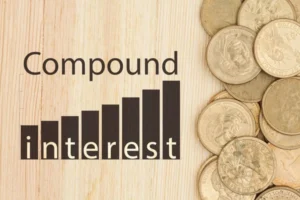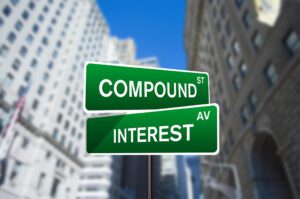
What is Compound Interest?: An Introduction
Contents
- 1 Compound Interest
- 1.1 What is Compound Interest?: An Introduction
- 1.2 Introduction
- 1.3 1. What is Compound Interest?
- 1.4 2. How Compound Interest Differs from Simple Interest
- 1.5 3. How Compound Interest Works
- 1.6 4. Advantages of Compound Interest
- 1.7 5. Disadvantages of Compound Interest
- 1.8 6. Examples of Compound Interest in Different Financial Products
- 1.9 7. Practical Tips to Maximize Compound Interest
- 1.10 8. The Rule of 72: Estimating Compound Interest Growth
- 1.11 Conclusion
- 1.12 FAQs
- 1.12.1 1. What is the difference between compound and simple interest?
- 1.12.2 2. How often should I compound interest for maximum growth?
- 1.12.3 3. Is compound interest beneficial for short-term investments?
- 1.12.4 4. Can compound interest work against me?
- 1.12.5 5. What types of accounts use compound interest?
- 1.13 Compound Interest
- 1.14 How to Calculate Compound Interest: A Step-by-Step Guide for Maximizing Your Returns
Compound Interest
What is Compound Interest?: An Introduction
Introduction


Compound interest is a powerful financial concept that can significantly impact the growth of your savings and investments. Understanding how compound interest works is crucial for anyone interested in maximizing their financial potential, whether in personal finance, investment strategies, or long-term wealth-building.
In this article, we’ll dive deep into compound interest—what it is, how it differs from simple interest, and how it benefits investors. We’ll also explore practical examples, advantages, disadvantages, and strategies to leverage compound interest to its full potential.
1. What is Compound Interest?
Compound interest is the process by which interest is calculated on an initial principal amount and on the accumulated interest from previous periods. Essentially, it is “interest on interest,” which makes the interest grow exponentially over time. In simple terms, compound interest adds to your initial amount not just once but continually, creating a powerful effect over time.
Formula for Compound Interest
The compound interest formula is given by:
A=P×(1+rn)n×tA = P \times \left(1 + \frac{r}{n}\right)^{n \times t}=P×(1+nr)n×t
where:
- A = Final amount (Principal + Interest)
- P = Initial principal balance
- r = Annual interest rate (decimal)
- n = Number of times interest is compounded per year
- t = Time (in years)
This formula helps you calculate the total amount based on initial investment, interest rate, compounding frequency, and time period.
Example
Suppose you invest $1,000 at a 5% annual interest rate, compounded annually. After one year, you will have:
A=1000×(1+0.051)1×1=1000×1.05=1050A = 1000 \times \left(1 + \frac{0.05}{1}\right)^{1 \times 1} = 1000 \times 1.05 = 1050=1000×(1+10.05)1×1=1000×1.05=1050
If left for ten years at the same rate and frequency, the initial $1,000 grows to $1,628.89, demonstrating the power of compound interest over time.


2. How Compound Interest Differs from Simple Interest
Simple interest is calculated solely on the principal amount, while compound interest includes the interest that has accumulated over time. Here’s a brief comparison:
- Simple Interest Formula: A=P(1+rt)A = P(1 + rt)=P(1+rt)
- Compound Interest Formula: A=P×(1+rn)n×tA = P \times (1 + \frac{r}{n})^{n \times t}=P×(1+nr)n×t
Example Comparison
If $1,000 is invested at a 5% annual interest rate over five years, here’s how the calculations differ:
- Simple Interest: 1000×(1+(0.05×5))=1000×1.25=12501000 \times (1 + (0.05 \times 5)) = 1000 \times 1.25 = 1250×(1+(0.05×5))=1000×1.25=1250
- Compound Interest: 1000×(1+0.051)1×5=1000×1.276=1276.281000 \times (1 + \frac{0.05}{1})^{1 \times 5} = 1000 \times 1.276 = 1276.28×(1+10.05)1×5=1000×1.276=1276.28
In this example, compound interest yields more than simple interest because it grows on the accumulated interest as well as the principal.
3. How Compound Interest Works
The growth from compound interest follows an exponential curve, meaning that the amount grows faster as time goes on. Compounding can occur at different frequencies:
- Annually: Interest is compounded once a year.
- Semi-Annually: Interest is compounded twice a year.
- Quarterly: Interest is compounded four times a year.
- Monthly: Interest is compounded twelve times a year.
- Daily: Interest is compounded 365 times a year.
Example of Compound Frequencies
For a $1,000 investment at a 5% annual rate:
- Annually: A=1000×(1+0.051)1×1=1050A = 1000 \times (1 + \frac{0.05}{1})^{1 \times 1} = 1050=1000×(1+10.05)1×1=1050
- Quarterly: A=1000×(1+0.054)4×1=1050.95A = 1000 \times (1 + \frac{0.05}{4})^{4 \times 1} = 1050.95=1000×(1+40.05)4×1=1050.95
- Monthly: A=1000×(1+0.0512)12×1=1051.16A = 1000 \times (1 + \frac{0.05}{12})^{12 \times 1} = 1051.16=1000×(1+120.05)12×1=1051.16
The more frequently interest is compounded, the greater the overall growth.
4. Advantages of Compound Interest
1. Accelerated Wealth Growth
Since compound interest grows on both the principal and the interest, it accelerates wealth accumulation. Over time, this exponential growth can lead to substantial returns on even modest investments.
2. Flexibility with Investments
You can leverage compound interest in various investment vehicles like savings accounts, bonds, stocks, and retirement accounts. These accounts generally allow for compounding, offering flexibility in wealth-building strategies.
3. Incentive for Long-Term Investment
Compound interest rewards patience. The longer you invest, the more compound interest will work in your favor. This makes it particularly beneficial for retirement planning and long-term financial goals.
4. Compounding Frequency Options
The frequency of compounding can be selected based on your investment objectives. For example, daily or monthly compounding can provide higher returns, making it easier to grow your money faster.
5. Reinforces Financial Discipline
Compound interest encourages consistent investing, as the benefits become more noticeable over time. Setting aside a fixed amount periodically helps investors build wealth consistently.


5. Disadvantages of Compound Interest
1. Requires Time for Significant Growth
One of the main drawbacks is that compound interest needs a longer period to show substantial growth. For individuals looking for short-term gains, it may not be suitable.
2. Potential for Debt Accumulation
Compound interest can work against you if you’re in debt. High-interest loans with compounding can accumulate quickly, making repayment challenging.
3. Risk of Lower Returns with Low-Interest Rates
If interest rates are low, the compounding effect might not generate substantial returns. This can be a limitation for investments that do not yield a high rate of interest.
4. Tax Implications
The interest accrued is often subject to taxes, which can reduce overall returns. High taxes on interest income can diminish the compounding benefits if not managed effectively.
6. Examples of Compound Interest in Different Financial Products
1. Savings Accounts
Many banks offer savings accounts with daily or monthly compounding, allowing even small deposits to grow over time. A savings account with compound interest is a good option for those who want a safe and low-risk investment.
2. Certificates of Deposit (CDs)
CDs generally offer a fixed rate of return with compounding interest. These are often used as medium-term investments, allowing individuals to lock in an interest rate for a specified period.
3. Mutual Funds and Stocks
Investments in mutual funds or dividend-paying stocks can also benefit from compounding. By reinvesting dividends and capital gains, investors can maximize their returns through compounding over time.
4. Retirement Accounts (401(k), IRAs)
Retirement accounts such as 401(k)s and IRAs leverage compound interest over decades, providing significant growth potential. Regular contributions and tax-deferred growth enhance the power of compounding.
5. Bonds
Certain bonds, like zero-coupon bonds, grow through compound interest. These bonds don’t pay interest periodically but grow over time and are redeemed at maturity for their face value.


7. Practical Tips to Maximize Compound Interest
- Start Early: Time is the most critical factor in compounding. The earlier you start investing, the more time your investments have to grow.
- Invest Regularly: Make consistent investments, even if they’re small. Over time, regular contributions increase your compound interest returns.
- Choose Higher Compounding Frequencies: Daily or monthly compounding yields higher returns compared to annual compounding.
- Focus on High-Interest Investments: Seek out accounts and products with competitive interest rates, as a higher rate amplifies compounding growth.
- Reinvest Returns: Instead of withdrawing interest or dividends, reinvest them to take advantage of compounding.
8. The Rule of 72: Estimating Compound Interest Growth
The Rule of 72 is a simple formula for estimating the number of years required to double your investment at a fixed annual compound interest rate. The formula is:
Years to Double=72Interest Rate\text{Years to Double} = \frac{72}{\text{Interest Rate}}=Interest Rate72
Example
If you’re investing at an 8% interest rate:
728=9 years\frac{72}{8} = 9 \text{ years}=9 years
This means it would take approximately nine years to double your investment with an 8% compounded interest rate.
Conclusion
Compound interest is a powerful tool that, when used strategically, can significantly impact your financial future. Whether you’re saving for retirement, investing in mutual funds, or simply building an emergency fund, understanding and utilizing compound interest can provide exponential growth over time. With the right strategies—such as starting early, reinvesting returns, and focusing on higher compounding frequencies—you can maximize the benefits of compound interest, transforming modest investments into substantial wealth.


FAQs
1. What is the difference between compound and simple interest?
Simple interest is calculated only on the principal amount, while compound interest is calculated on both the principal and the accumulated interest.
2. How often should I compound interest for maximum growth?
More frequent compounding, such as daily or monthly, generally yields better returns than annual compounding due to the added accumulation effect.
3. Is compound interest beneficial for short-term investments?
Compound interest is most effective over the long term, so it may not be as beneficial for short-term gains.
4. Can compound interest work against me?
Yes, compound interest can accumulate debt rapidly if you’re paying interest on loans or credit cards, leading to a significant repayment burden.
5. What types of accounts use compound interest?
Savings accounts, certificates of deposit, retirement accounts, and bonds are common accounts that leverage compound interest for growth.





















1 comment